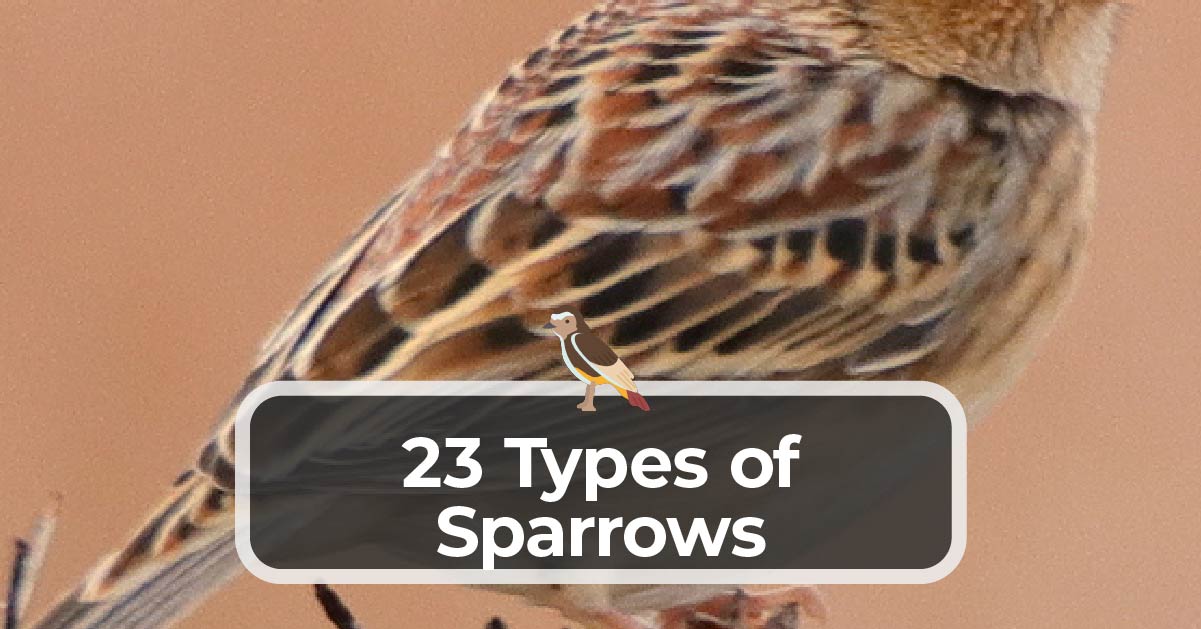Sparrows are very common, widespread birds. There are more than 50 sparrow species found in North America alone. Sparrows are small birds with relatively short tails and thick necks. They don't sing as well as other songbirds, however, they are still quite musical in their way.
Read more on what kind of baby bird is this on our blog!
Many people see sparrows as pests or disease carriers and want to eliminate them. However, these wild bird species play an important role in the local ecosystem by eating insects and spreading seeds around your yard. Here are the common sparrows you would mostly run into on a hike, at the park, on the beach, or in your backyard:
1. Grasshopper Sparrow
Grasshopper Sparrow is a tiny gray and brown bird with pale eyes and a thin beak. Grasshopper Sparrows spend the winter in the Southern U.S and Mexico, then migrate to the north in the summer to breed across the middle and northern half of the eastern U.S.

They're on the small side and have a slightly more squat appearance than other sparrows, with a shorter neck and flat head. Other unique features include a deep bill that gives their mouth a larger appearance when open. As their name suggests, these sparrows enjoy eating grasshoppers during the winter.
2. Song Sparrow
The song sparrow is a widespread, common sparrow. It's difficult to identify song sparrow because of its relatively bland, streaked plumage. The males will perch on exposed branches during spring and summer and sing to attract mates and defend territory.

These birds also sing a lot. Males and females search for places to nest together and build hidden in tall grasses and weeds. Song sparrows will visit bird feeders and aren't afraid of nesting near humans.
3. Fox Sparrow
The fox sparrow has both a red and gray plumage morph. Fox sparrows are widespread in North America and can look similar to the song sparrow. The markings are similar, with thick triangular or arrowhead-shaped spotting and streaking on the breasts and flanks.

Fox sparrows also have a thin eye-ring and a smudge on plumage variations. They're a common sparrow but reclusive, preferring to stay in dense thickets and bushes. They may come to backyard feeders to pick at the seed that has fallen to the ground but is more likely to visit fruiting shrubs.
4. White Throated Sparrow
White-throated sparrow is common in the eastern United States during the winter and throughout Canada during the summer, with small areas of year-round populations where the ranges overlap. Their white throat patch makes them easier to identify among sparrows, along with their bold facial pattern of black and white stripes with yellow spots between the eyes.

White throated sparrows will visit your backyard feeder and also like to pick up seed off the ground. To encourage white throated sparrows into your yard, keep some bush piles nearby so that they can hide.
5. Eurasian Tree Sparrow
The Eurasian tree sparrow is a non-native species that looks strikingly similar to the male house sparrow but has a brown cap instead of a gray one, and the black on its chin and chest is much extensive. Eurasian tree sparrow also has a black patch on the cheek.
6. Vesper Sparrow
Vesper sparrow has a streaked back and wings, light brown streaking on the chest and a plain belly, white ring around the eye and white outer tail feathers. Vesper sparrows can be found in the northern half of North America during the summer breeding season and southern North America in the fall and winter.
Vesper means evening song, which describes this sparrow's habit of singing after sunset when most other birds have gone quiet. They like to be out in the open when they sing and choose elevated perches such as wires on the top of fence posts and the tops of shrubs.
7. Lark Sparrow
The identifying feature in the lark sparrow is its multicolored head. The strong facial pattern of lark sparrow includes rufous, white warm brown and black, paired with a relatively plain body. They have a pale chest with one central black spot, and the tip of the tail has white spots on the edges. They're commonly found in the central and western United States during summer.
8. Golden Crowned Sparrow
The golden crowned sparrow is a common bird of western North America. They're often found in sagebrush habitats and are seen foraging on the ground or taking perches on fence posts to sing their loud, ringing song. Golden crowned sparrow is named for its bold, bright yellow crown that contrasts starkly with a darker head and gray cheek.
These are common winter birds along the pacific coast and are summer residents along Canada's Pacific coast and throughout Alaska. In winter, they may extend much further east in mountainous regions.
9. Clay Colored Sparrow
The clay colored sparrow is a small sparrow of the southwestern United States. It gets its name from its brownish upperparts, streaked with black and pale buff or gray underparts. Its short, conical bill is pinkish. The sexes are similar in appearance.
The clay colored sparrow is common in Southern Canada and northern plain states during the summer. In the winter, clay colored sparrows migrate to Southern Texas and Mexico. Besides, its markings are not as bold as other sparrow species, so they can be challenging to identify.
However, the head stripes are the clearest features, including the white eyebrow and pale mustache. The gray neck can also contrast with the buff colored chest and back. They like keeping their breeding and foraging areas separate, making their breeding territory fairly small.
10. Savannah Sparrow
The savannah sparrow is a streaked bird that prefers open areas and often gathers in large flocks for migration. The key field mark in the savannah sparrow includes the heavier patterning on the face, a yellow splotch above and in front of the eye.
There are many subspecies of savannah sparrows in specific geographic locations, and some have different coloring. The strength of the streaking on the rest of the body can vary regionally in color, thickness, and spread but will retain the same general pattern.
11. Leconte's Sparrow
Leconte's sparrow is a shy sparrow typically found in central Canada in the summer and along the central Gulf Coast of the United States in winter after following a narrow migration path through the great plains.
The clearest field mark for LeConte's sparrow is its broad head streaks washed with rich gold or orange buff hues and some wide central white head stripe. Other good field marks include the gray cheek and the gray neck with fine stripes, which are visible.
12. Olive Sparrow
The olive sparrow is a sparrow that is typically found in the southwestern United States and Mexico. It resembles the chipping sparrow but has a larger bill, is more rufous-colored on its upperparts and has bolder streaks on its breast.
13. Chipping Sparrow
The chipping sparrow is a small American sparrow. The chipping sparrow is a common summer bird throughout the United States and Canada, with winter populations extending into the southern states and Mexico. The chipping sparrow is easily recognized by its bold rufous crown, black eye stripe, white or gray eyebrow, and clear gray breast and abdomen.

14. Slate Dark Eyed Junco
The slate dark eyed junco or junco hyemalis is a common winter bird throughout the United States and spends summers in the boreal regions of Canada and Alaska. They are commonly known as snowbirds because of the gray sparrows. These birds only prefer colder climates and only appear in the winter.
Dark eyed juncos have many plumage morphs. The slate colored junco is the most common in the east with its rich, gray coloration and contrasting white abdomen. Another key field mark is its pink bill.
15. Lincoln's Sparrow
Lincoln's sparrow is a medium sparrow with a streaking brown and chests and sides, chestnut striping on the head and a pale eye-ring. Lincoln's sparrow spends summers in Canada and Alaska, migrates through the U.S and winter in the southern U.S and Mexico. Lincoln's sparrows prefer to remain concealed in the vegetation of meadows and marshes. While migrating, they may mix with flocks of other sparrows.
16. American Tree Sparrow
The American tree sparrow prefers colder climates and spends summers in northern Canada and Alaska, while its winters are in the United States' northern parts. It prefers brushy habitats and often mingles in mixed flocks with other sparrows or juncos. The rusty cap, which the bird can raise or lower as a small crest, is a good field mark.

The dark, blurry spot in the center of a clear grayish white breast, plus the rusty eye line, two toned bills, and white wing bars, are other good markings to look for when identifying American tree sparrow.
17. Field Sparrow
The field sparrow is a year-round resident in the eastern half of the U.S in grasslands, prairies and fields. Field sparrows have a buffy gray body with brown and white striping on the wing, a pink beak, a brown cap and a brown spot behind the eye.
18. Brewer's Sparrow
Brewer's sparrows have a smaller range than many other sparrows and are mainly found in the central states. In the west and southwest, they live in sagebrush habitats. They're so well adapted to the dry environment that they can go weeks without drinking.
There is also a subspecies that lives in the timberline of Canadian mountains. The appearance of the brewer's sparrow is so drab, giving it the name of a bird without a field mark and lacking any easily distinguishing feature. Males fill the early morning desert landscape with their long, thrilling songs during the breeding season.
19. White Crowned Sparrow
Thanks to its bold bandit head pattern of thick black and white stripes, the white crowned sparrow is easy to distinguish. Other distinctive features include the pale bill and grayish body. The ground foraging behavior and double footed scratching hop is another important field mark for this bird species. White crowned sparrow is a familiar bird in the western United States throughout Canada and less common in the east.
20. Male House Sparrow
The house sparrow or Passer domesticus is the most widespread and familiar of any North American sparrow species and is widely found throughout Europe, South America and Asia. Originally a European bird, house sparrows were introduced in Brooklyn, New York, in 1851, rapidly spreading across the continent.
The male birds have a distinct brown plumage, gray cap, black bill and black bib on a gray chest, all clear field markings for easy identification.
21. Swamp Sparrow
The swamp sparrow is a small dark brown and gray bird with a rusty cap and black eye stripe. It is found in marshes, bogs and wet meadows of the northern and western United States and Canada. Swamp sparrows only nest in wetland habitats and like to stay among tall reeds, bush and vegetation.
They have slightly longer legs than other sparrows, which helps them wade through marsh water when foraging. Other spring backyard nesters that share the same features as swamp sparrow include the sage sparrow and the seaside sparrow.
22. Oregon Dark Eyed Junco
This is another variation of dark eyed junco, which is distinctive with its prominent dark hood, brown back and rufous wash on the flanks. Like most other junco variations, Oregon juncos have pink bills. It's the most common junco in the west, with populations migrating as far south as northern Mexico and the Baja Peninsula.
23. Black Throated Sparrow
Thanks to its stark head pattern, the black throated sparrow is well worth seeing. Being named for its black throat, the black throated sparrow has a throat set by bright white borders that match the white eyebrow, giving it a bandit look-like name. Its range is limited to desert regions of the west and southwest United States and Mexico.
FAQs on Types of Sparrows
What is interesting about sparrows?
Sparrows are very small birds, and they usually live close to humans and build their nests on buildings and, more often, in trees. Sparrows are very common birds, and this is why people like to watch them live. They make a lot of sounds, but the sound of their chirping can be very annoying.
How do I take care of baby sparrows?
If you have a baby sparrow as a pet, you can care for it just like how you take care of baby birds of different kinds. As long as you give it good shelter and food, sparrows will thrive. These birds love where there are people and will appreciate good care from their owners.
Final Thought on the Types of Sparrows
As you can see, sparrows come in many forms and shapes, but they are all very similar in how they live their lives. Sparrows are not endangered, but some rare sparrow types might be in danger soon.





